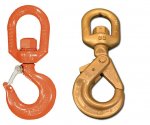- 1,673
- 898
- 113
- Location
- Central NY
I have seen a couple of pics of peoples winches that use a swivel hook instead of a fixed hook.
None of the factory winches installed on military vehicles have swivel hooks. This is why:
When using twisted rope (ie., all steel cable winch ropes), a swivel hook will allow the the cable to partially unwind under load. Thus, the cable that enters the winch and goes on the drum has an inherent torsional load on it, a twist set up like a spring.
When next payed out 'free spool' or pulled out manually in a power-out situation, that torsional load will want to re-wind back to its free condition. Like the 'memory' of a cheap hose or electrical cord.
This can then 'birds nest' or worse. Also, when unwound a little, debris can work into the cable more than normal and be trapped when retensioned next time is it loaded - premature wear, abrasion, expelling grease etc.
Fixed hooks will not allow the cable to 'unwind' and as soon as the load is released, the cable will be at rest and therefore no spring twist, just like when it was put on the drum at the factory.
Swivel hooks are for woven cables, or cables that have opposite twists to internal layers or for two part lifting like cranes where swiveling a load is necessary. None of these cable types untwist when loaded.
Swivel type:- ................................ Fixed type:-

 (ones on right are ESMET type, as used by military)
(ones on right are ESMET type, as used by military)
If you are using a swivel hook and are comfortable with how it works then please ignore this observation.
None of the factory winches installed on military vehicles have swivel hooks. This is why:
When using twisted rope (ie., all steel cable winch ropes), a swivel hook will allow the the cable to partially unwind under load. Thus, the cable that enters the winch and goes on the drum has an inherent torsional load on it, a twist set up like a spring.
When next payed out 'free spool' or pulled out manually in a power-out situation, that torsional load will want to re-wind back to its free condition. Like the 'memory' of a cheap hose or electrical cord.
This can then 'birds nest' or worse. Also, when unwound a little, debris can work into the cable more than normal and be trapped when retensioned next time is it loaded - premature wear, abrasion, expelling grease etc.
Fixed hooks will not allow the cable to 'unwind' and as soon as the load is released, the cable will be at rest and therefore no spring twist, just like when it was put on the drum at the factory.
Swivel hooks are for woven cables, or cables that have opposite twists to internal layers or for two part lifting like cranes where swiveling a load is necessary. None of these cable types untwist when loaded.
Swivel type:- ................................ Fixed type:-

 (ones on right are ESMET type, as used by military)
(ones on right are ESMET type, as used by military)If you are using a swivel hook and are comfortable with how it works then please ignore this observation.
Last edited:

